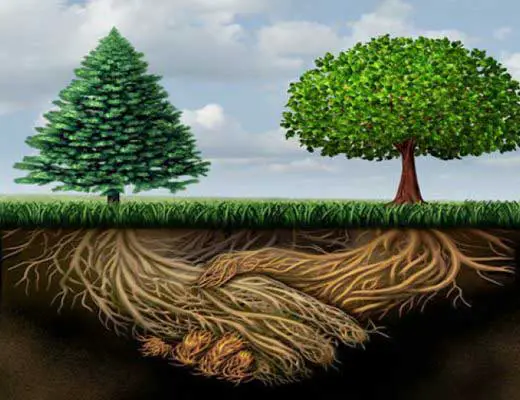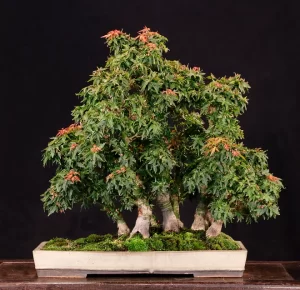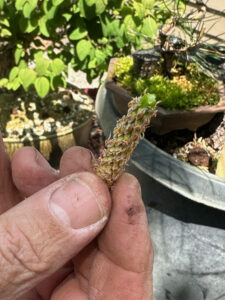
WHAT IS MYCORRHIZAE
Submitted by Leonard J. Wegryn February 26, 1996
Terminology:
Mycorrhizae- Is a collective term for several distinct kinds of beneficial fungi. Fungus is & Fungi are- A growth that forms during decomposition of organic matter. Pathogens- Are disease producing organisms,
Symbiotic—Is a relationship of the structure built from the mutually beneficial interaction of the small absorbing root and a particular type of fungus, working as a team.
What is mycorrhizae?
In virtually every plant there is a hidden, almost invisible silent partner working to maintain the health and vitality of that tree. That silent partner is mycorrhizae.
In the simplest terms, mycorrhizae is one of the two systems by which a tree or plant takes in water and minerals from the soil. Root hairs are one system, and mycorrhizae the other, but it’s much more than that. All forest and landscape trees and more than 92% of plants world wide have mycorrhizae in the soil composition, naturally. Without mycorrhizae they would lose their vitality, disease resistance, and longevity.
In nature, as new roots grow, they first develop root hairs for uptake of water and dissolved minerals from the soil solution. Then, gradually, over a period of several weeks, a large proportion of the absorbing roots are—beneficially– invaded and become colonized by the mycorrhizae fungi.
The functions of mycorrhizae in the soil are:
- It increases root absorption surfaces.
- It has the ability to render substances in the soil (phosphorus, zinc, manganese and copper) available to the host plant.
- It detoxifies the environment for the host plant, thus, protecting against pathogenic invasion. Protection is accomplished by utilizing root carbohydrates and other chemicals which would be attractive and would be utilized by the pathogens.
- It provides a physical barrier to pathogens in the form of a fungus mantle.
- It secretes antibiotics which inhibit or kill pathogens.
- It supports a protective rhizosphere population of other micro-organisms.
- It stimulates root cells of the host plant during symbiotic periods to utilize chemical inhibitors. Inhibitors function to maintain symbiosis but may also inhibit infection by pathogens.
A bonsai soil-less growing medium is, or should be, composed of all sterile ingredients, and so, may be barren of mycorrhizae. The addition of mycorrhizae compost to a mix completes it as an ideal basic bonsai soil, assuring successful growing throughout the life of the tree.
In view of the importance of the presence of mycorrhizae in the root area of all plants, it follows that, when repotting a healthy plant, bare rooting it drastically depletes this beneficial ingredient.
Additional information generated by ChatGPT
Mycorrhizae are mutually beneficial associations between fungi and plant roots. The word “mycorrhizae” is derived from the Greek words “mykes” (meaning fungus) and “rhiza” (meaning root).
The fungal partner in mycorrhizal associations provides the plant with increased access to nutrients, such as phosphorus and nitrogen, that are essential for plant growth and development. In return, the plant provides the fungus with sugars and other organic compounds produced by photosynthesis.
There are two main types of mycorrhizae: ectomycorrhizae and endomycorrhizae. Ectomycorrhizae form a sheath around the outside of plant roots, while endomycorrhizae penetrate the root cells themselves.
Mycorrhizal associations are common in many plant species, including trees, shrubs, and herbaceous plants, and are found in a variety of ecosystems, from forests to grasslands to wetlands. These associations play a crucial role in the health and productivity of many ecosystems.
How does this relate to bonsai?
Mycorrhizal associations can be beneficial for bonsai trees because they help the trees absorb nutrients from the soil. Bonsai trees are often grown in small containers with limited soil, which can make it difficult for them to obtain all the nutrients they need. Mycorrhizal fungi can help by increasing the surface area of the roots, allowing them to absorb more nutrients and water.
Additionally, bonsai trees are often pruned and trained to maintain their small size and shape, which can cause stress to the trees. Mycorrhizal fungi can help mitigate this stress by increasing the tree’s resistance to diseases and pests, and by improving its ability to withstand environmental stresses such as drought or high temperatures.
Many bonsai enthusiasts add mycorrhizal fungi to the soil mix or use products containing mycorrhizae to promote healthy growth and development of their trees. However, it’s important to note that the use of mycorrhizal fungi is just one of many factors that contribute to the health and success of a bonsai tree, and should be used in combination with proper watering, fertilization, and other care techniques.



